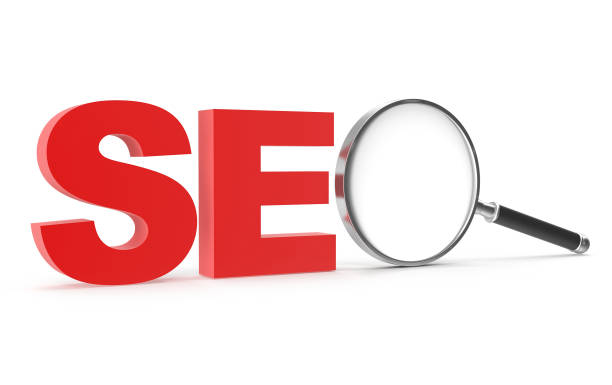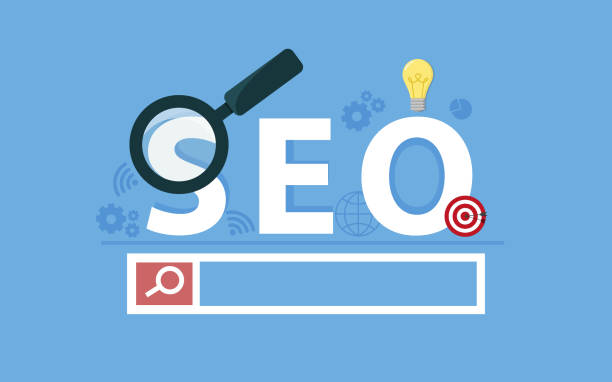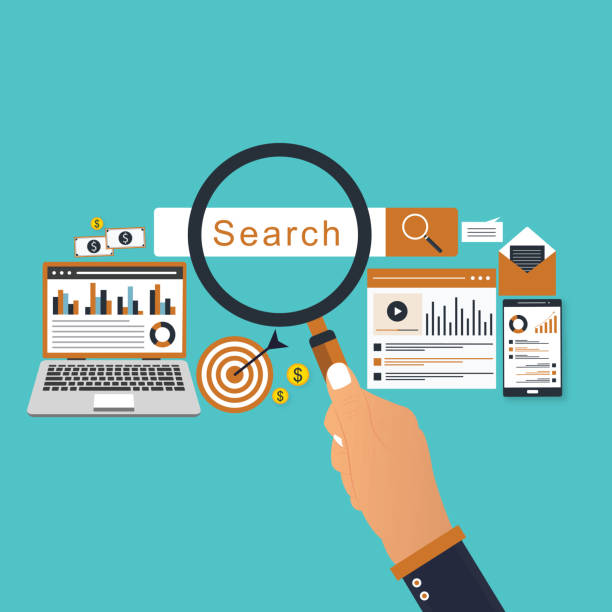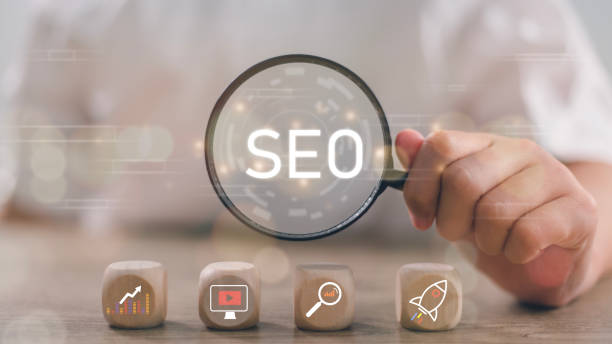Introduction to SEO and its Importance in Today’s World

In the age of information and communication, an online presence is vital for any business.
But simply having a website is not enough; you need to ensure that users can find it.
This is where the role of SEO (Search Engine Optimization) becomes prominent.
SEO is a set of techniques and strategies that help improve your website’s ranking in search engine results like Google.
The main goal of SEO is to increase organic (non-paid) and high-quality traffic to your website.
With a better ranking, your website gets more visibility, and the chances of attracting potential customers increase.
The importance of SEO is not limited to just increasing visits; it also helps build trust and credibility for your brand.
When users see your website at the top of search results, they consider it more credible and reliable.
This process is an educational and continuous approach that requires constant monitoring and updating.
SEO is not just a marketing tool, but a long-term investment for survival and growth in the digital space.
One of the #key concepts in this field is understanding how search engine algorithms work, which are constantly evolving.
Did you know that 94% of users’ first impressions of a business are related to its website design? With professional corporate website design by **Rasawb**, turn this first impression into an opportunity for growth.
✅ Attract more customers and increase sales
✅ Build credibility and trust in the eyes of the audience⚡ Get a free website design consultation!
Types of SEO and Their Fundamental Differences

To gain a comprehensive understanding of SEO, it is essential to become familiar with its different types.
Generally, SEO is divided into three main categories: On-Page SEO, Off-Page SEO, and Technical SEO.
Each of these sections covers different aspects of your website, and collaboration and coordination between them are essential for overall SEO success.
On-Page SEO refers to all actions taken within your website to improve its ranking.
This includes content optimization, proper keyword usage, optimizing titles and meta descriptions, URL structure, and internal linking.
The goal of On-Page SEO is to send clear signals to search engines about the content of your pages.
This aspect of SEO is very descriptive and practical.
Off-Page SEO, unlike On-Page SEO, deals with activities performed outside your website to increase its authority and popularity.
The most important factor in Off-Page SEO is building high-quality backlinks from other reputable websites.
These backlinks act like a vote of confidence and show search engines that your website has valuable content.
Other activities include social media presence, forum participation, and content marketing on other platforms.
Technical SEO focuses on improving the website’s technical infrastructure so that search engines can easily crawl and index your website.
This includes improving site loading speed, mobile-friendliness, code structure, Robots.txt file, XML sitemap, and the use of structured data (Schema Markup).
All three types of SEO are interdependent, and a comprehensive SEO strategy must include all three to achieve the best results.
This specialized approach requires deep knowledge in each area.
Keyword Research, the Cornerstone of SEO Success

Keyword Research is one of the first and most crucial steps in any successful SEO strategy.
Without understanding what phrases users are searching for, it’s impossible to create content that addresses their needs and appears in search results.
Keyword research helps you identify the words and phrases that users type into search engines and that are relevant to the products, services, or information you offer.
This process is not just about finding high-volume keywords, but also includes understanding the user’s intent (Search Intent) behind each search.
This stage is, in a way, a fundamental guidance for the entire SEO project.
User intent can be divided into four main categories:
| Intent Type | Description | Keyword Example |
|---|---|---|
| Informational | The user is looking for information about a topic. | “What is SEO?”, “How to cook Ghormeh Sabzi” |
| Navigational | The user intends to go to a specific website or page. | “Digikala”, “Facebook login” |
| Commercial | The user is researching to buy a product or service. | “Best Samsung phone”, “Lenovo vs Asus laptop comparison” |
| Transactional | The user is ready to buy or perform a specific action. | “Buy Tehran Mashhad flight ticket”, “Download SEO software” |
Tools like Google Keyword Planner, Ahrefs, Semrush, and Moz Keyword Explorer can assist in this process.
After identifying keywords, you should categorize and prioritize them based on search volume, competition, and relevance to your content.
This specialized part of SEO requires extensive accuracy and analysis.
A strong keyword research strategy will be the foundation for success in all subsequent SEO stages and will help you produce targeted and effective content.
Content Optimization for Search Engines

Producing high-quality content optimized for search engines is one of the main pillars of On-Page SEO.
Content should not only be understandable to search engines but also fully address the needs and questions of users.
Your content must have added value and be unique.
To optimize content, you should first naturally incorporate relevant keywords into your text.
This means avoiding excessive repetition of a keyword (Keyword Stuffing), as this can be identified by search engines as an unnatural practice and harm your ranking.
Instead, use synonyms and related keywords (LSI Keywords).
Content structure is also highly important.
Using appropriate headings (H1, H2, H3, etc.) helps organize content and improves its readability.
Additionally, by examining these headings, search engines can gain a better understanding of the main topic of the page.
Short paragraphs, the use of lists (Bullet Points), and relevant images with proper alt descriptions all contribute to improving user experience and content SEO.
Images should be compressed to avoid reducing page loading speed.
Furthermore, content length can also influence ranking.
Comprehensive and in-depth content that addresses all aspects of a topic usually achieves a better ranking.
But more important than length is the quality and usefulness of the content.
A short but highly useful piece of content can perform better than a long and worthless one.
Creating engaging content that encourages user interaction, or analytical content that provides deep insights, can help attract links and increase website authority.
Ultimately, content SEO is a process that requires a deep understanding of both audiences and search engines simultaneously.
Are you tired of your company’s website not meeting your expectations? With Rasawb, design a professional website that truly represents your business.
✅ Increase acquisition of new customers and sales leads
✅ Enhance your brand’s credibility and trust with your audience
⚡ Get a free website design consultation!
Technical SEO and its Role in Ranking Improvement

Technical SEO is the foundation of a healthy and optimized website for search engines.
This part of SEO addresses the technical aspects of a website that directly affect its crawlability, indexing, and ranking.
Without a strong technical infrastructure, even the best content may never be properly seen by search engines.
One of the most important factors in Technical SEO is site loading speed.
Both users and search engines value high speed.
Slow websites create a poor user experience and may drop in rankings.
Tools like Google PageSpeed Insights can help you identify speed issues.
Mobile-Friendliness is also highly important, especially given the significant increase in mobile device usage for searching.
Google’s Mobile-First Indexing means that the mobile version of your website will be the primary basis for your ranking.
URL structure, using HTTPS for security, and managing redirects are also key aspects of Technical SEO.
Using an XML sitemap and a Robots.txt file is essential for guiding search engine bots in crawling your website.
The sitemap helps engines find all your important pages, while Robots.txt tells them which pages should not be crawled.
Structured data (Schema Markup) also helps search engines better understand your content and display it in more appealing ways (such as Rich Snippets) in search results.
This can significantly increase your click-through rate (CTR).
This aspect of SEO is a specialized and technical part that requires programming and webmaster knowledge.
Continuous improvement of Technical SEO ensures that your website is “readable” to search engines and sets the stage for the success of On-Page and Off-Page SEO strategies.
Backlinks and Domain Authority in Off-Page SEO

Off-Page SEO primarily focuses on building backlinks, which act as a vote of confidence from other websites to your website.
The greater the number and quality of backlinks your website receives, the more authoritative and trustworthy search engines will consider it, which helps improve your ranking.
However, it’s not just the number of backlinks that matters, but also the quality and relevance of the linking websites.
Receiving backlinks from websites with high Domain Authority and relevance to your field of activity has a much greater impact than low-quality links.
Link building strategies include creating valuable content that naturally attracts links, Broken Link Building, sponsored articles (advertorials), social media engagement, and local business directories.
Black Hat SEO link-building techniques, such as buying links or using link networks, should be strictly avoided, as these methods can lead to penalties from Google and a severe drop in rankings.
A natural and diverse link profile indicates the credibility and popularity of your website.
In addition to backlinks, other factors also play a role in Off-Page SEO, including social media presence.
Although social signals are not directly involved in ranking, they can help increase the visibility of your content and, consequently, attract natural backlinks.
Online reputation and user reviews can also play a role in Off-Page SEO, especially for local SEO.
Managing online reputation and responding to user reviews, especially negative ones, can create a positive image for your business.
Off-Page SEO is a continuous and time-consuming process that requires public relations and content marketing strategies.
This aspect of SEO is often news-driven and related to current industry trends.
Local SEO and its Importance for Physical Businesses

Local SEO refers to a set of actions that help local businesses appear in search results for users near their geographical location.
This type of SEO is crucial for stores, restaurants, clinics, and any business that provides services in a specific geographical area.
The main goal of Local SEO is to attract potential customers near your business’s physical location.
One of the most important tools for Local SEO is the Google My Business profile.
Optimizing this profile with accurate and complete information, high-quality photos, and correct business hours is the first step towards success in Local SEO.
In addition to Google My Business, other factors also influence Local SEO.
These factors include NAP Citations (Name, Address, Phone Number), which display your business’s contact information on websites and online directories, as well as user reviews and ratings.
Encouraging customers to leave positive reviews and responding to them can increase your business’s credibility.
This process is often a guiding activity for customers.
| Factor | Description | Importance for Local SEO |
|---|---|---|
| Google My Business Profile | Business information in Google Maps and local results | Very high; foundation for local visibility |
| NAP Citations | Consistent Name, Address, and Phone Number in directories | High; increases credibility and data consistency |
| Online Reviews and Ratings | Customer feedback on various platforms | Medium to high; impacts user decision-making and ranking |
| Local Link Building | Backlinks from relevant local websites | Medium; strengthens local authority |
Optimizing website content with local keywords (e.g., “Italian restaurant in Shiraz”) and creating Local Landing Pages can also help improve local rankings.
These pages should include precise location information and content relevant to services in that area.
Ultimately, Local SEO enables physical businesses to reach their target customers in a competitive market and increase their store traffic.
This part of SEO requires a specialized approach focused on specific geography.
SEO and User Experience (UX): Connection and Synergy

In the past, SEO and User Experience (UX) were often considered two separate fields, but today these two concepts are increasingly intertwined.
Search engines, especially Google, are increasingly emphasizing factors related to user experience for website ranking.
This means that a website with poor UX, even with the best On-Page and Off-Page SEO optimizations, may not achieve a good ranking in search results.
Google’s ultimate goal is to provide the best and most relevant experience to its users, and websites that fulfill this goal are rewarded.
One of the most important UX-related metrics in SEO is Google’s Core Web Vitals.
This includes three main metrics: LCP (Largest Contentful Paint), which measures the loading speed of the main content; FID (First Input Delay), which relates to the site’s responsiveness to user interaction; and CLS (Cumulative Layout Shift), which assesses the visual stability of the page.
Improving these metrics directly contributes to better SEO rankings.
Other UX factors influencing SEO include:
- Navigation Ease: A logical website structure and clear navigation menu help users easily find the information they need, and this also assists search engines in understanding the site’s structure.
- Content Readability: Using appropriate fonts, sufficient text size, short paragraphs, and enough white space makes content easy to read for users and can reduce the Bounce Rate.
- Mobile Responsiveness: As previously mentioned, responsive design that displays your website well on any device is crucial for SEO.
- Dwell Time and Bounce Rate: If users quickly leave your site after entering (high bounce rate) or spend little time on it, this is a negative signal for search engines, indicating that your content is not engaging or useful.
Improving UX can enhance these metrics.
The relationship between SEO and UX is synergistic; improving one helps the other.
By focusing on providing an excellent user experience, you are naturally performing strong and sustainable SEO.
This approach is engaging for users and rewarding for search engines.
Are you worried that your company’s old website might scare away new customers? Rasawb solves this problem by designing a modern and efficient corporate website.
✅ Increases your brand’s credibility.
✅ Helps attract targeted customers.
⚡ Contact Rasawb for a free website design consultation!
Monitoring and Data Analysis in SEO Campaigns
![]()
Implementing an SEO strategy without continuous data monitoring and analysis is like driving with your eyes closed.
To ensure the effectiveness of SEO efforts and identify opportunities for improvement, website performance must be regularly reviewed and analyzed.
This process is an analytical and crucial part of any SEO campaign.
Various tools are available for this purpose, among the most important of which are Google Analytics and Google Search Console.
Google Analytics provides comprehensive information about your website traffic, including the number of visitors, pages viewed, time spent on site, bounce rate, traffic sources (organic search, social media, direct, etc.), and user behavior.
By analyzing this data, you can understand which parts of your content are most popular, how users interact with your site, and what your strengths and weaknesses are.
This information can help you improve your content SEO strategy and user experience.
Google Search Console is also an essential tool for any SEO specialist, providing direct information from Google about your website’s performance in search results.
This tool shows you:
- Which keywords have led to your site appearing in search results.
- The number of clicks and impressions for each keyword.
- Crawling and indexing issues (such as 404 errors or blocked pages).
- Security or manual actions issues.
- The status of your site’s Core Web Vitals.
By using this information, you can resolve technical issues, refine your keyword strategy, and identify new opportunities for SEO growth.
In addition to these tools, key performance indicators (KPIs) such as keyword rankings, organic traffic, organic search conversion rates, and the value of organic traffic should be regularly monitored.
Regular and transparent reporting on these metrics demonstrates the importance of SEO efforts to stakeholders and aids informed decision-making for future optimizations.
This continuous monitoring process has an important explanatory and educational aspect.
The Future of SEO and Upcoming Trends

The world of SEO is constantly evolving, and what is effective today may become obsolete tomorrow.
For long-term success in SEO, it is essential to be familiar with new trends and update strategies accordingly.
Artificial Intelligence (AI) and machine learning are playing an increasing role in how search engines operate.
Algorithms like BERT and MUM enable Google to better understand the intent behind searches and provide more relevant results.
This means that producing comprehensive, high-quality, and in-depth content that answers complex questions will become even more important.
Voice Search is also growing, and its impact on SEO is increasing.
Users tend to use longer, more natural phrases (Long-tail Keywords) when performing voice searches.
Optimizing for voice search requires understanding conversational language and providing direct, concise answers.
Furthermore, Video SEO has gained significant importance due to the popularity of platforms like YouTube.
Optimizing titles, descriptions, tags, and subtitles for videos can help improve their visibility in search results.
The concept of E-E-A-T (Experience, Expertise, Authoritativeness, Trustworthiness), introduced by Google, is becoming a highly important ranking factor.
This means that websites should not only provide high-quality content but also demonstrate that their content is produced by experienced and expert individuals and is trustworthy.
This is especially crucial for websites in health, finance, and legal fields (Your Money Your Life – YMYL).
This approach is an analytical and predictive perspective.
SEO is no longer limited to just keywords; it relates to a deep understanding of users, providing the best possible experience, and building online credibility.
By focusing on these upcoming trends, businesses can ensure that their SEO strategy remains effective in the future and contributes to their sustainable growth.
This path is a continuous guidance for success.
Frequently Asked Questions
| Question | Answer |
|---|---|
| What is SEO? | SEO, or Search Engine Optimization, is the process of increasing the quality and quantity of website traffic by improving the site’s ranking in organic search results of search engines like Google. |
| What are the main types of SEO? | SEO is divided into three main categories: On-Page SEO, Off-Page SEO, and Technical SEO. |
| What does On-Page SEO include? | On-Page SEO involves optimizing elements within the website, such as keywords, Title Tags, Meta Descriptions, content, URL structure, images, and internal links. |
| What is Off-Page SEO? | Off-Page SEO refers to activities outside the website that help improve its ranking, such as Backlink Building, social media marketing, and Brand Mentions. |
| What is Technical SEO? | Technical SEO focuses on optimizing the technical aspects of a website to help it be better crawled and indexed by search engines. This includes site speed, mobile-friendliness, site structure, Sitemaps, and the Robots.txt file. |
| What role do Keywords play in SEO? | Keywords are phrases that users type into search engines. Proper and targeted use of relevant keywords in content and site elements helps search engines understand the topic of your page and display it for relevant searches. |
| What is a Backlink and why is it important? | A backlink, or inbound link, is a link from one website to another. Backlinks act as a “vote of confidence” from other sites for search engines and play an important role in a site’s authority and ranking improvement, especially if they come from reputable sites. |
| How does quality content affect SEO? | High-quality, relevant, comprehensive, and unique content not only attracts and retains users but also shows search engines that your page is valuable. This helps improve rankings, reduce Bounce Rate, and increase user dwell time on the site. |
| Why is site loading speed important for SEO? | Site loading speed is an important ranking factor for Google. Faster sites offer a better user experience, have lower bounce rates, and are preferred by search engines. |
| Is SEO a one-time process? | No, SEO is a continuous and long-term process. Search engine algorithms are constantly changing, competition is increasing, and website content also needs updating. Therefore, SEO requires continuous monitoring, analysis, and optimization. |
And other advertising services by Rasawb Advertising Agency
Smart Custom Software: A professional solution for analyzing customer behavior with a focus on custom programming.
Smart Marketing Automation: A new service for enhancing customer behavior analysis through attractive UI design.
Smart Digital Branding: A combination of creativity and technology for analyzing customer behavior by precise audience targeting.
Smart Link Building: A creative platform for improving click-through rate increase with Google Ads management.
Smart Brand Identity: A fast and efficient solution for customer acquisition with a focus on custom programming.
And over hundreds of other services in the field of internet advertising, advertising consultation, and organizational solutions
Internet Advertising | Advertising Strategy | Advertorial
Sources
Comprehensive SEO Guide What is SEO? Technical SEO Tutorial Content SEO and Content Marketing
? Are you ready to transform your business in the digital world? Rasawb Afarin Digital Marketing Agency paves your path to online success by providing innovative solutions including responsive website design and professional optimization. To gain visibility, grow, and increase customers, contact us today.
📍 Tehran, Mirdamad Street, next to Bank Markazi, Southern Kazeroon Alley, Ramin Alley, Building No. 6




